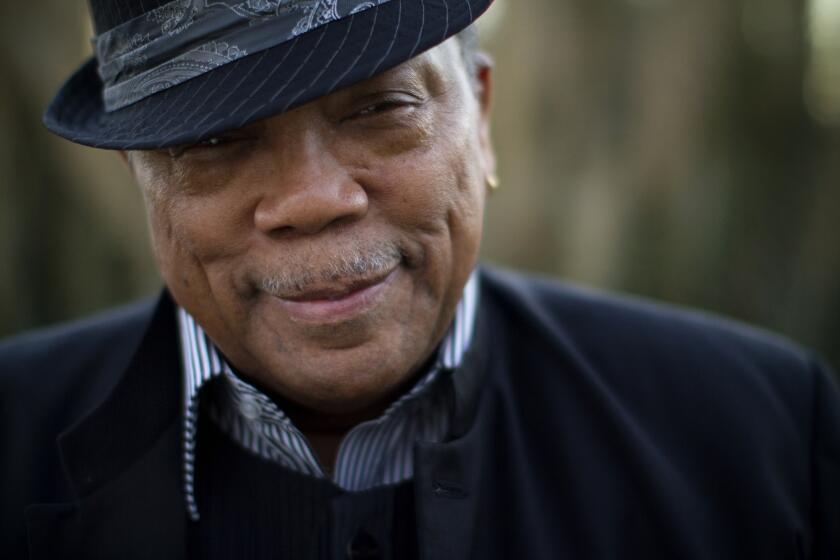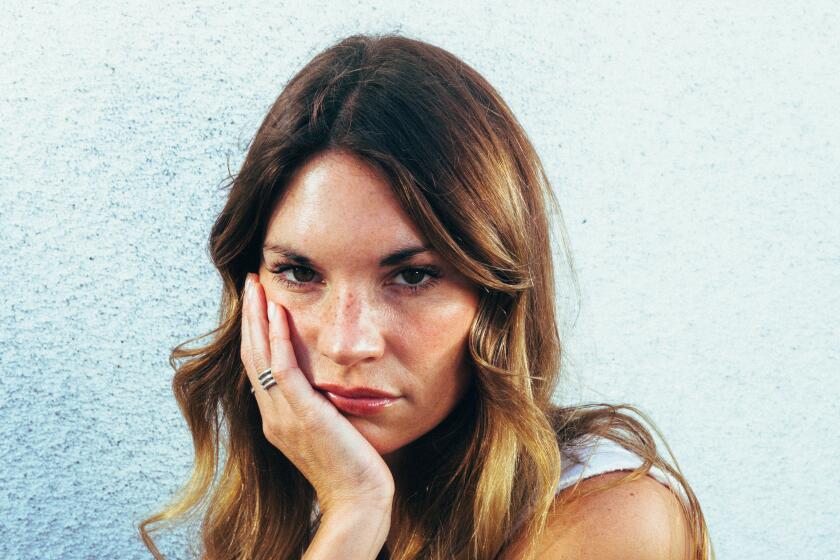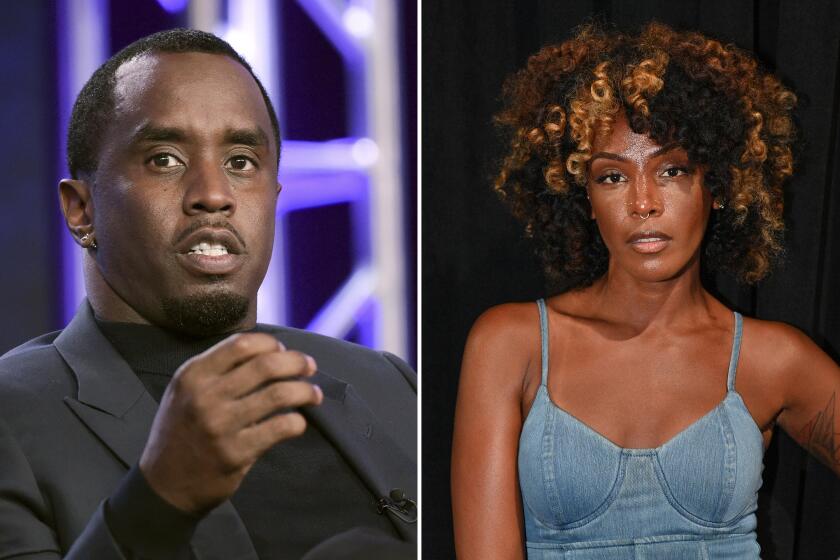Beyonce: Lady sings the blues
NEW YORK — On a recent slate-gray afternoon in New York, Beyonce zipped quickly through the front door of trendy Rivington Hotel on Manhattan’s Lower East Side. The singer, her hair pulled back tightly, was wearing an immaculate black suit and perfectly knotted necktie that gave her a playful “VictorVictoria” look, one suggesting to the gawking bystanders that the Rivington’s latest guest just might be the world’s most Superfly stockbroker.
Upstairs, in the hotel’s window-walled penthouse, the 27-year-old sat back, sipped a glass of water and announced that, like her suit, she was all about business with flair: “Barbra Streisand, that’s the career model for me, I want to be like her. She is just the ultimate. And I want to be an icon too.”
It’s a bold statement, but Beyonce is someone willing to pursue her goals fearlessly. She got her first record deal when most kids are getting their driver’s licenses, and she recently married longtime love Jay-Z, the rapper whose relentless careerism is legend. At this point, she must move past any remaining preconceptions that she’s like the character she played in the lavish musical “Dreamgirls,” a talented beauty without truly defining textures, a torch singer without real fire.
A pair of new projects might shatter finally any such notions. The singer has a new double album, “I am . . . Sasha Fierce,” which follows the model of notable releases in recent years from OutKast and Justin Timberlake in bundling two conceptually different discs into one package. Here, “Sasha Fierce” is the pop glamour and dance-floor manifesto while “I am . . . “ is the surprise, a collection that might be expected more from Alicia Keys with its neo-soul emotion.
That disc is a companion piece of sorts to Beyonce’s upcoming film, “Cadillac Records,” in which she plays Etta James. James, who was born Jamesette Hawkins in Los Angeles in 1938, still performs at blues festivals and was given a Grammy lifetime achievement award in 2002. Her signature hit was the swooning ballad “At Last,” which has become a staple of film and commercials, but her grittier soul recordings made her a key influence on singers such as Janis Joplin and Bonnie Raitt. Beyonce said the singer was “a powerful woman but also so troubled, and that comes across in her music.”
The movie, due in theaters Dec. 5, stars Adrien Brody as scruffy music impresario Leonard Chess and chronicles the 1950s Chicago music scene and its backstage scandals, recalling both “Dreamgirls” and Taylor Hackford’s Oscar-winning “Ray.”
Beyonce said she surprised the film’s director, Darnell Martin, with her willingness to go gritty. She gained 20 pounds and dotted her arms with track marks to portray the R&B; pioneer, who struggled with heroin addiction during that era. The singer spent a few days at the Phoenix House, a rehab center in Brooklyn, to learn the junkie stagger and addled rage she uses to surprising poignant effect in the movie.
“I never tried drugs in my life so I didn’t know about it all,” she said. “It was hard to go there. In the beginning I didn’t want to offend anyone, I didn’t want to ask the wrong questions or seem judgmental. They were so honest, though, and I am so thankful. I don’t think I could have understood that level of pain or need. What they do there is amazing. I learned a lot about life and myself.”
Taking it all in came with a price, though. The relentlessly optimistic Beyonce said the role left her badly rattled, even after the cameras stopped rolling.
“I wasn’t sure I could even do it,” Beyonce said. “I read Etta’s book and watched every video of her I could find. I wanted to do her justice. She’s a real woman that had guts and was unapologetic. . . . I wanted to have the swollen eyes and the veins in my face too. I wanted to make it real. But during the filming, you couldn’t talk to me. I am a very happy person, I am, and I realize how blessed I am, so to be in such a painful place. . . . It was one of the hardest things I’ve ever done.”
When it was over, Beyonce said she realized she was still living with James’ spirit, and that ultimately influenced the way she performed the songs on “I Am . . .” It led to the introspection and almost alt-folk vibe of the single “If I Were a Boy” and the rock bravery of “That’s Why You’re Beautiful.”
“I’m the most proud of that movie, more than anything I’ve done so far,” she said. “More than anything, it changed me. It changed my art. It changed my way of looking at everything; my approach to the songs I chose and the way I sang [on the “I Am . . . “] record. I kept it a lot cleaner and lot more simple. In the studio, I sang those songs the same way as if I had a scene with my acting coach. I was in there crying, screaming and sweating, all of that. . . . All of that is in the music. I couldn’t go from that to just singing anything. It had everything to do with ‘I Am . . . ‘ Those songs are just from the heart.”
Etta James also gave Beyonce the bravery to go with the spare, acoustic “Satellite,” which Beyonce said that, before the “Cadillac Records” experience, she would have likely put in the pile of forgotten demos. “It’s so honest I don’t think I would have ever put it on an album. I felt like I’m ready to reveal that side of me, the real side of me. I’m not afraid to do something different. I really wasn’t afraid to step out of the pop-star box or whatever box people put on me.”
It wasn’t so long ago that the single-monikered aspiring icon was more commonly known as Beyonce Giselle Knowles, living back in Houston with her father and manager, Mathew Knowles, a former IBM salesman, and her mom, Tina. At 19, she was fronting Destiny’s Child, the pop group that took career notes from the Supremes and especially TLC, and ended up selling 18 million albums in the United States and many times that abroad.
In many ways, despite the sleek Manhattan lifestyle, Beyonce is still proudly Texan. She has the honeyed Houston drawl and the deep affection for big hair and huge earrings. Really, this Sasha Fierce alter ego she has been using to promote the new album was born years ago at Headliners beauty parlor, where the customers in the spinning chairs came to get their hair swept up by Tina Knowles and found themselves a captive audience for rehearsals of the salon owner’s talented young daughter.
Beyonce returned to Houston to work on songs for the new album. In all, she recorded 75 tracks, a staggering amount. “It’s crazy, I know,” she said. “I’m just an extremist. I don’t know how to do things in moderation. I go all the way. I usually record about three songs a day.”
How can she possibly find that much quality material? “Even if I don’t love it, I’ll try it. If I just have a little bit of an idea about it or I hear a little thing in it I like, I’ll give it a chance. I might not finish it. We might go back and change the track. I like to experiment.”
In other words, Beyonce approaches the studio like a boutique’s dressing room. “Absolutely,” she said with a big grin. “I don’t mind trying it on at all!”
There was another reason for the massive stockpiling of music: Mathew Knowles, still his daughter’s business manager, was a part of the team that negotiated separate pre-sale agreements with 30 retailers and online digital-music merchants, with each of them getting some form of exclusive content from the considerable vault of new material.
Beyonce might be looking to 20th century icons for music sensibility, but with her licensing deals, fashion line, the new international website and her relentless promotion, she is clearly doing business in a 21st century style. The new album -- which Times Pop Music Critic Ann Powers described as “full of interesting choices” but not without some “unfortunate missteps” -- has a song called “Video Phone” and, yes, it does hint at an upcoming advertising campaign, which suggests that the singer is not above tilting art until it is completely in the service of commerce.
Beyonce clearly seeks out role models and thumbs through music history the way some people browse catalogs. She carefully channeled the icy perfection of Diana Ross in “Dreamgirls” and jumped at the chance to perform with Tina Turner at February’s Grammy Awards ceremony. Now comes her turn as Etta James, and, on Dec. 7, she will seek out her hero, Streisand; Beyonce will perform “The Way We Were” at the Kennedy Center Honors and she already has butterflies.
“It’s amazing. It’s beautiful,” she said. “When you’re a little girl you don’t think you’ll meet these people, these giants. You get to speak to them and ask them whatever you want. It makes you stand up straight too, absolutely. I have so many things to ask her.”
Next up for her is the early 2009 release of “Obsessed,” a thriller that gave Beyonce a taste for shooting action films. She wants to follow that up with a superhero movie, the in-vogue thing these days (“I would love,” she confided, “to play Wonder Woman!”). There’s a massive concert tour in the works and the ongoing struggle to balance career and marriage as well as the sometimes bumpy work relationship with her parents (her mother guides her film career while her father handles the music pursuits).
“It does get hard sometimes, but we agree on probably 92% of everything,” she said.
Beyonce eventually wants to do a Broadway show too, and maybe think about starting a family of her own, though she said, “right now I don’t have that desire.”
At the moment, her main impulse is to find more feature films like “Cadillac Records” because, somehow, in becoming Etta James, she learned a lot about being Beyonce. “It was really one of the best decisions I have ever made, doing that movie. Before I was still really insecure and scared and now I have the confidence . . . at the end of making that movie, it was like I had gone through therapy or something. I felt so comfortable. I felt like a whole new woman, like I was ready for the world and ready to reveal me. The real me.”
--
More to Read
The biggest entertainment stories
Get our big stories about Hollywood, film, television, music, arts, culture and more right in your inbox as soon as they publish.
You may occasionally receive promotional content from the Los Angeles Times.










